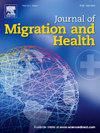Effects of state immigrant insurance coverage policies on access to adequate prenatal care among immigrant pregnant women in the United States
IF 2.9
Q1 PUBLIC, ENVIRONMENTAL & OCCUPATIONAL HEALTH
引用次数: 0
Abstract
Background
The 1996 federal welfare and immigration reform restricted immigrant eligibility for public health insurance such as Medicaid and CHIP. As of January 2023, 34 states have adopted policies to expand insurance coverage for immigrant pregnant individuals through Medicaid/CHIP.
Objective
To estimate the effects of state immigrant insurance policies on prenatal care utilization and timing among pregnant immigrants.
Methods
A difference-in-differences approach was used to compare states that expanded immigrant insurance coverage to those that did not. The main data source is the restricted natality data from the National Center for Health Statistics, including all singleton births to immigrant mothers aged 15–44 across all 50 states and D.C. from 2015 to 2019.
Results
In states adopting the State-only funds option, publicly insured immigrants had higher odds of receiving intermediate (OR: 1.429; 95 % CI: 1.210–1.687), adequate (OR: 1.723; 95 % CI: 1.526–1.946), and adequate plus (OR: 1.373; 95 % CI: 1.256–1.500) prenatal care, and lower odds of inadequate care (OR: 0.480; 95 % CI: 0.406–0.568) compared to uninsured immigrants. Additionally, this policy was associated with an 87.1 percentage point increase in first-trimester care initiation (95 % CI: 1.622–2.159), and significant decreases in delayed care (−43.8 pp; 95 % CI: 0.430–0.736) and no care until delivery (−67.3 pp; 95 % CI: 0.204–0.522) for publicly insured immigrant populations compared to uninsured immigrants.
Conclusions
Expanding immigrant insurance coverage was associated with earlier and more adequate prenatal care. However, only State-only funds showed consistent improvements in the adequacy of prenatal care utilization.
美国州移民保险政策对移民孕妇获得适当产前护理的影响
1996年的联邦福利和移民改革限制了移民获得公共医疗保险的资格,如医疗补助和CHIP。截至2023年1月,34个州已经采取政策,通过医疗补助/CHIP扩大对移民孕妇的保险范围。目的评估国家移民保险政策对怀孕移民产前护理利用和时机的影响。方法采用差异中的差异方法来比较扩大移民保险覆盖范围的州和没有扩大移民保险覆盖范围的州。主要数据来源是国家卫生统计中心的限制性出生数据,包括2015年至2019年所有50个州和华盛顿特区15-44岁移民母亲的所有单胎分娩。结果在采用州级基金方案的州,公共保险移民获得中级保险的几率更高(OR: 1.429;95% CI: 1.210-1.687),足够(OR: 1.723;95% CI: 1.526-1.946)和充足+ (OR: 1.373;95% CI: 1.256-1.500)产前护理,护理不足的几率较低(OR: 0.480;95% CI: 0.406-0.568),与没有保险的移民相比。此外,该政策与妊娠早期护理起始率增加87.1个百分点(95% CI: 1.622-2.159)相关,延迟护理率显著降低(- 43.8 pp;95% CI: 0.430-0.736),分娩前无护理(- 67.3 pp;95% CI: 0.204-0.522),与未投保的移民相比。结论移民保险覆盖面的扩大与早期和更充分的产前护理有关。然而,只有国家专用基金在充分利用产前护理方面持续改善。
本文章由计算机程序翻译,如有差异,请以英文原文为准。
求助全文
约1分钟内获得全文
求助全文
来源期刊

Journal of Migration and Health
Social Sciences-Sociology and Political Science
CiteScore
5.70
自引率
8.70%
发文量
65
审稿时长
153 days
 求助内容:
求助内容: 应助结果提醒方式:
应助结果提醒方式:


